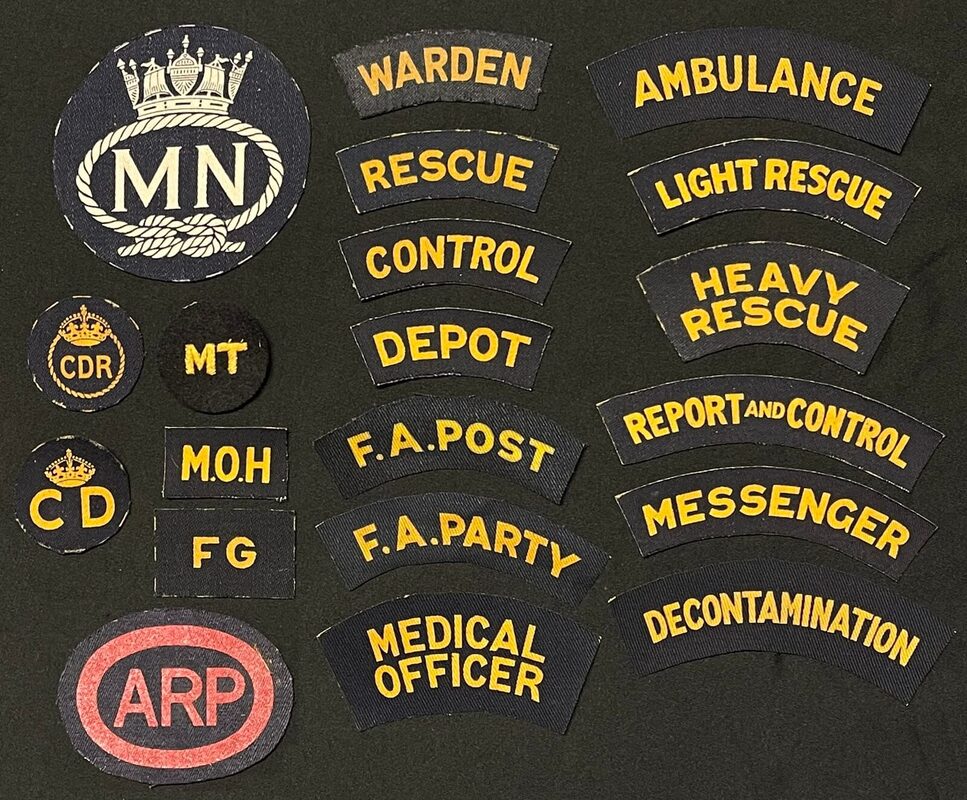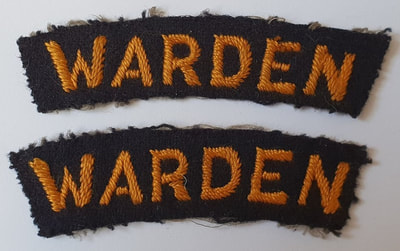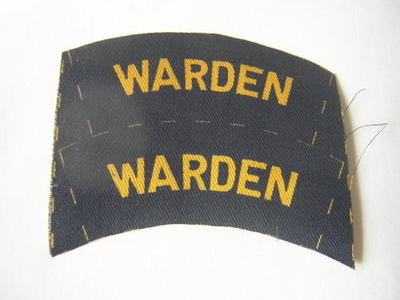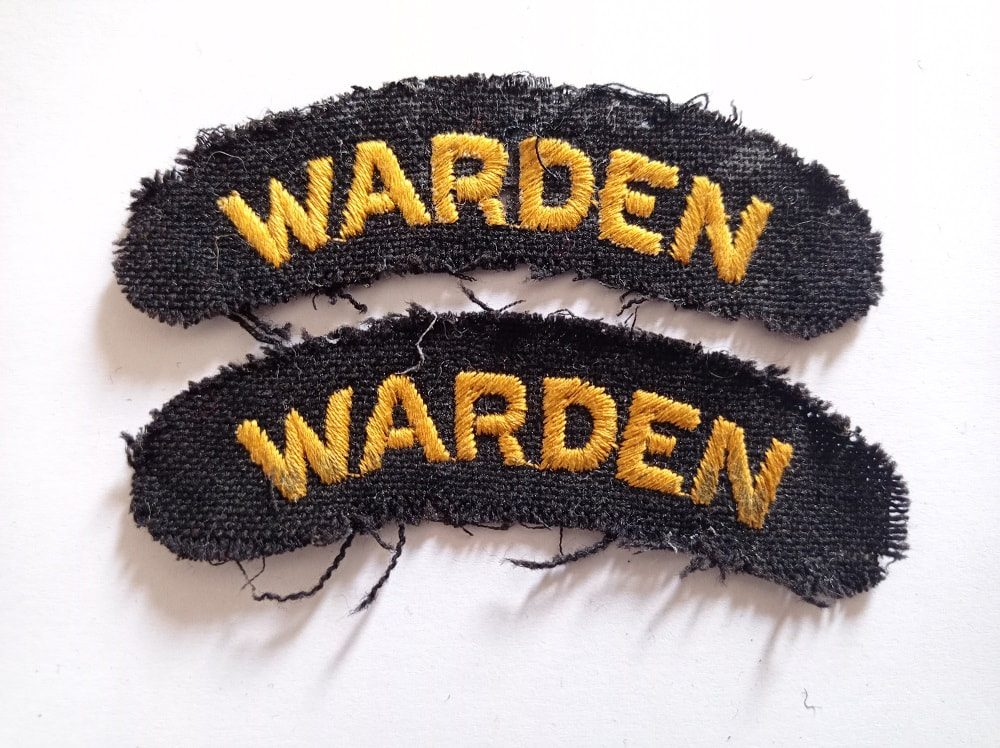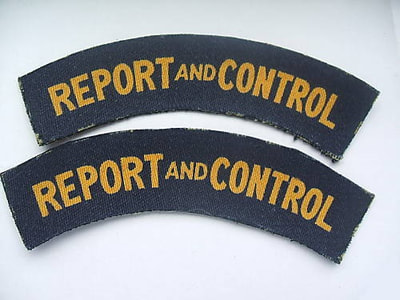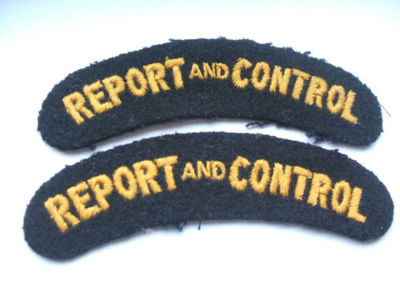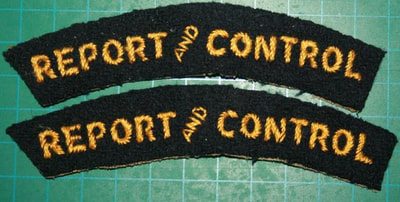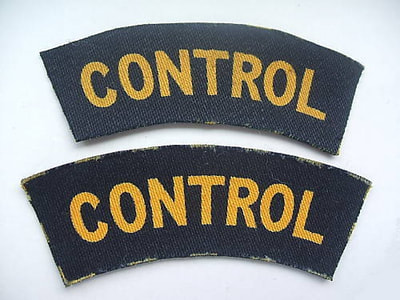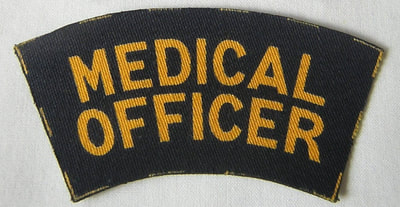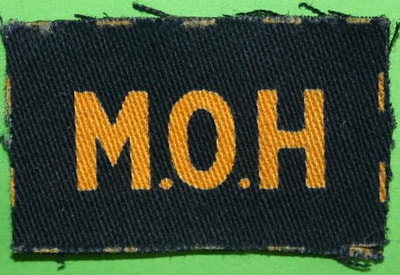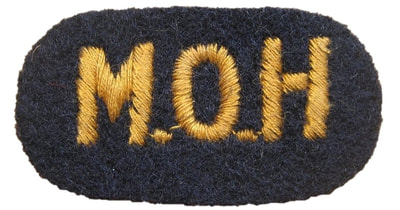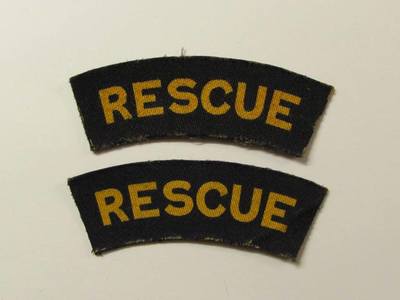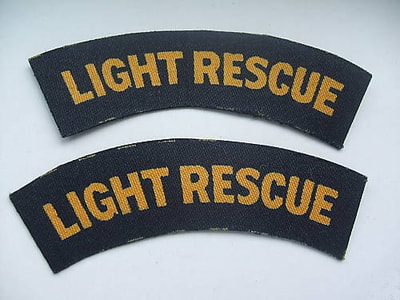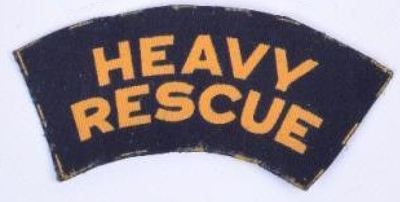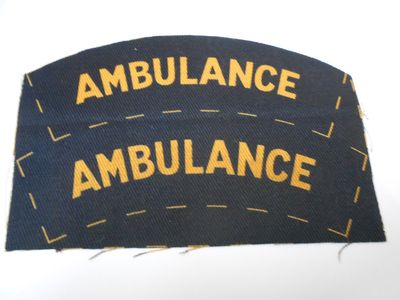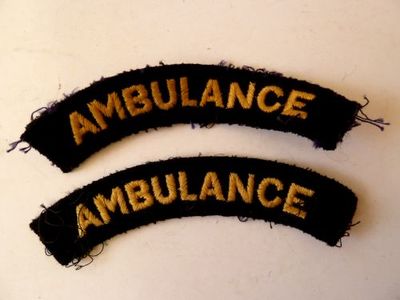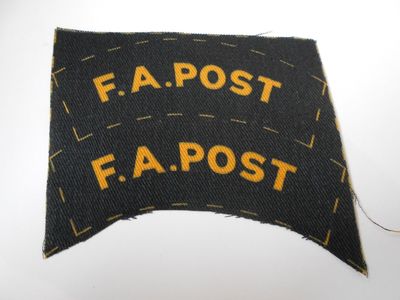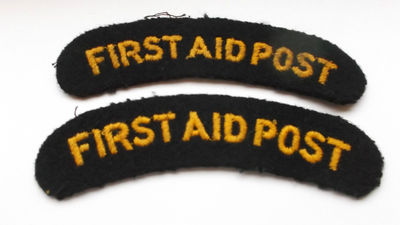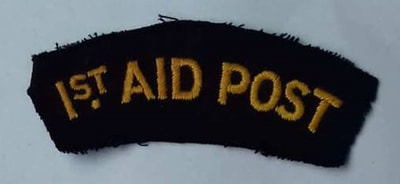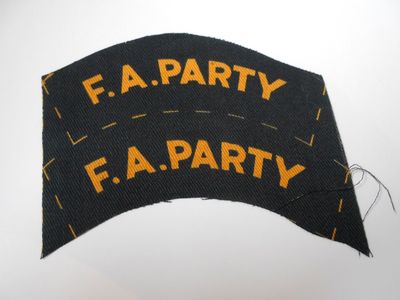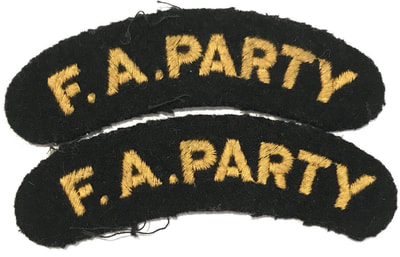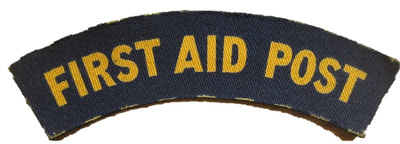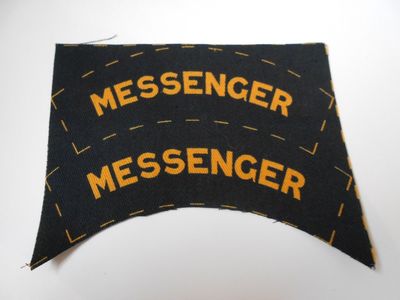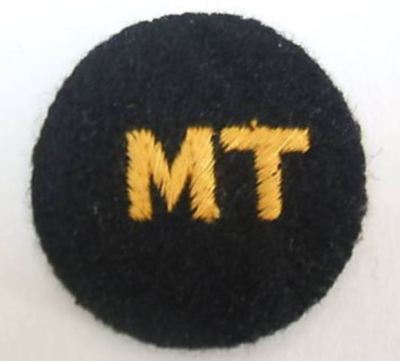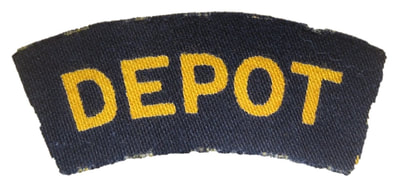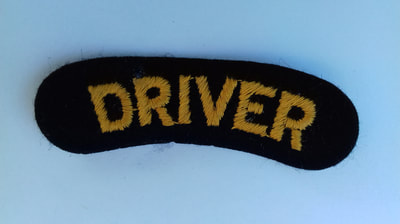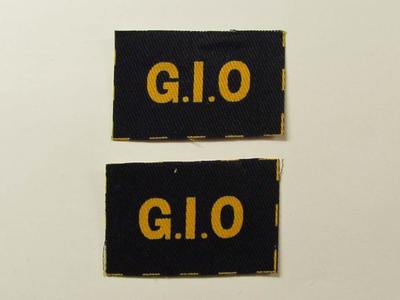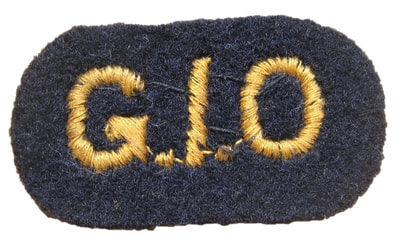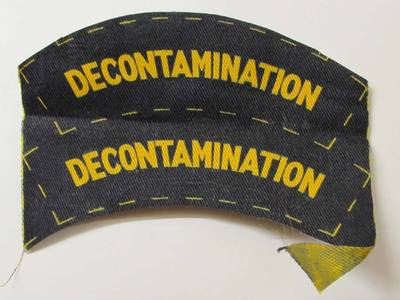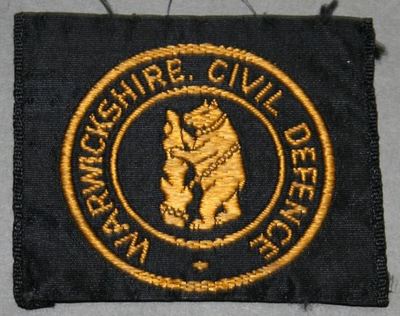WW2 Civil Defence Shoulder Titles / Flashes
Many of the positions appearing on shoulder titles (sometimes also referred to as shoulder flashes) within the Civil Defence Services were laid out within Regulation 29BA of the "Defence (General) Regulations, 1939" Act. Most positions were part-time with volunteers expected to undertake 48 hours of service over a four week period (more when emergencies/incidents required it).
Titles became officially available on 2 December 1941 and were initially embroidered but calico-printed versions became available from the middle of 1943 (for cost saving reasons). The shoulder titles below are those that were officially sanctioned. However, some local authorities allowed some ranks to have shoulder titles that displayed their actual rank; examples of "CHIEF WARDEN" and "SENIOR WARDEN" are known to exist.
Titles became officially available on 2 December 1941 and were initially embroidered but calico-printed versions became available from the middle of 1943 (for cost saving reasons). The shoulder titles below are those that were officially sanctioned. However, some local authorities allowed some ranks to have shoulder titles that displayed their actual rank; examples of "CHIEF WARDEN" and "SENIOR WARDEN" are known to exist.
ARP Warden Shoulder Titles (ARP Pattern 120)
The "WARDEN" was the on-the-ground link between the general public and the local authority's ARP services. Wardens were responsible for keeping the ARP Control Centre aware of any bombing damage, manage incidents and give advice and help to the public. Officially introduced for wear on battledress in September 1941, it took time for the titles to reach every location. Variations - such as "HEAD WARDEN", "SENIOR WARDEN" and "CHIEF WARDEN" - exist but these were ordered by local authorities and were not officially sanctioned.
Report & Control Shoulder Titles (ARP Pattern 125)
The Civil Defence "REPORT & CONTROL" Centre was the focal point of Civil Defence operations. The information sent by ARP wardens would be reviewed and the necessary emergency services sent to deal with the incident. Wardens telephoned in incidents but also filed forms which in the event that the telephone network was down were delivered by Messengers (often teenagers from the scouts or similar groups). A high number of women were taken on to receive and transmit accurately oral, written and telephone messages and also record and report on the progress of air raids.
Medical Officers Shoulder Titles (ARP Pattern 129 & 131)
The "MEDICAL OFFICER" was stationed at control centres and were responsible for organising the First Aid Parties. The M.O.H. titles stood for "MEDICAL OFFICER of HEALTH" (not Ministry of Health).
Rescue Party Shoulder Titles - Light (ARP Pattern 134) & Heavy (ARP Pattern 133)
Rescue Parties usually consisted of between eight and twelve men, usually builders, carpenters and plumbers etc. They were trained to remove casualties from bombed buildings and to make safe weakened buildings using wooden supports or where necessary demolish unsafe structures. Originally, just a 'RESCUE' shoulder title was implemented in 1941.
"LIGHT RESCUE" was introduced in the first half of 1942 and replaced "STRETCHER PARTY" in London (though they never had that exact wording as an official shoulder title) and "FIRST AID PARTY" elsewhere in the country (though it is undoubtedly the case that some continued to wear "FA PARTY" shoulder titles). "LIGHT RESCUE" undertook initial first aid, casualty collection, transfer to first aid posts and ambulances and rescue from buildings.
"HEAVY RESCUE" squads were sent to ensure buildings were safe for other Civil Defence Services to enter. The squad would shore up walls, test floors and where necessary demolish unsafe structures.
"LIGHT RESCUE" was introduced in the first half of 1942 and replaced "STRETCHER PARTY" in London (though they never had that exact wording as an official shoulder title) and "FIRST AID PARTY" elsewhere in the country (though it is undoubtedly the case that some continued to wear "FA PARTY" shoulder titles). "LIGHT RESCUE" undertook initial first aid, casualty collection, transfer to first aid posts and ambulances and rescue from buildings.
"HEAVY RESCUE" squads were sent to ensure buildings were safe for other Civil Defence Services to enter. The squad would shore up walls, test floors and where necessary demolish unsafe structures.
Ambulance Shoulder Titles (ARP Pattern 121)
Ambulances included commercial vehicles and cars converted for the purpose of carrying casualties. The "AMBULANCE" shoulder title was worn by ambulance drivers and attendants. In addition MOBILE UNITS were vans fitted with medical supplies and manned by a doctor, nurse and volunteer first aid personnel.
Several AMBULANCE DEPOTS were set up within a local authority and the ARP Controller would call on the depot for ambulances to attend to an air raid incident. Casualties suffering minor injuries were transferred to a FIRST AID POST and the more serious injuries were driven straight to a local hospital.
Several AMBULANCE DEPOTS were set up within a local authority and the ARP Controller would call on the depot for ambulances to attend to an air raid incident. Casualties suffering minor injuries were transferred to a FIRST AID POST and the more serious injuries were driven straight to a local hospital.
First Aid Parties / First Aid Post (ARP Pattern 122) Shoulder Titles
First Aid Parties
Volunteers were generally taken on aged up to 55. The collection and transport of the injured was undertaken by a four-man FIRST AID PARTY (in London these were known as STRETCHER PARTIES). Casualties were conveyed to ambulances or sitting-case cars (often driven by volunteers) for onward transport to either a FIRST AID POST or local hospital. They were under the command of the Medical Officer of Health (see "MOH" above).
The First Aid Party would have stretchers attached to their vehicle and carry first aid haversacks as well as spare gas respirators. Within an urban area, FIRST AID PARTIES’ DEPOTS were set up (no more than two miles between depots) that allowed the parties to quickly attend to an air raid incident. It was envisaged that a casualty would be no more than a mile from a First Aid Post in urban areas.
First Aid Posts
Volunteers within the ARP medical service were trained by a first aid organisation such as the St. John Ambulance (St. Andrew’s Ambulance Assoc. in Scotland), the British Red Cross Society (BRCS) and similar bodies such as the Royal Life Saving Society (RLSS).
In urban areas, FIRST AID POSTS were set up in small hospitals, health centres and clinics. They were staffed by at least one doctor and first aiders. They dealt with minor injuries and minor gas casualties, close to where they were injured. Casualties would then be released to go home or sent to a local hospital.
First Aid Posts were segregated and equipped to deal with three main types of casualties: people contaminated with gas but otherwise unharmed; the wounded and/or gassed but not contaminated; and the wounded and/or gassed and contaminated. The severely wounded and those suffering lung problems from gas were sent directly to a local hospital.
First Aid Point
In rural areas, FIRST AID POINTS would be set in church halls and private homes and stocked with necessary medical supplies to deal with minor injuries.
Volunteers were generally taken on aged up to 55. The collection and transport of the injured was undertaken by a four-man FIRST AID PARTY (in London these were known as STRETCHER PARTIES). Casualties were conveyed to ambulances or sitting-case cars (often driven by volunteers) for onward transport to either a FIRST AID POST or local hospital. They were under the command of the Medical Officer of Health (see "MOH" above).
The First Aid Party would have stretchers attached to their vehicle and carry first aid haversacks as well as spare gas respirators. Within an urban area, FIRST AID PARTIES’ DEPOTS were set up (no more than two miles between depots) that allowed the parties to quickly attend to an air raid incident. It was envisaged that a casualty would be no more than a mile from a First Aid Post in urban areas.
First Aid Posts
Volunteers within the ARP medical service were trained by a first aid organisation such as the St. John Ambulance (St. Andrew’s Ambulance Assoc. in Scotland), the British Red Cross Society (BRCS) and similar bodies such as the Royal Life Saving Society (RLSS).
In urban areas, FIRST AID POSTS were set up in small hospitals, health centres and clinics. They were staffed by at least one doctor and first aiders. They dealt with minor injuries and minor gas casualties, close to where they were injured. Casualties would then be released to go home or sent to a local hospital.
First Aid Posts were segregated and equipped to deal with three main types of casualties: people contaminated with gas but otherwise unharmed; the wounded and/or gassed but not contaminated; and the wounded and/or gassed and contaminated. The severely wounded and those suffering lung problems from gas were sent directly to a local hospital.
First Aid Point
In rural areas, FIRST AID POINTS would be set in church halls and private homes and stocked with necessary medical supplies to deal with minor injuries.
Messenger (ARP Pattern 126), MT (ARP Pattern 113), Depot & Driver Shoulder Titles
Although officially the age was 18 and up to be a "MESSENGER", many teenagers from various groups also volunteered (e.g. Scouts and Girl Guides to name but two). They were to carry messages between wardens and the report centres both during and after air raids.
"MT" was for personnel responsible for maintaining the vehicles at a depot. The "DEPOT" was worn by depot superintendents. "DRIVER" was an unofficial title but often worn by ambulance drivers to differentiate themselves from the ambulance attendants.
"MT" was for personnel responsible for maintaining the vehicles at a depot. The "DEPOT" was worn by depot superintendents. "DRIVER" was an unofficial title but often worn by ambulance drivers to differentiate themselves from the ambulance attendants.
Gas Decontamination (ARP Pattern 124) & Gas Identification Officer (ARP Pattern 127) Shoulder Titles
The 'G.I.O' (Gas Identification Officer) and his assistants were responsible for identifying which sort of gas or chemical had been used in an attack. The 'DECONTAMINATION' squads (made up of physically fit men aged up to 55) were then to be used to decontaminate streets and buildings. Decontamination squads often supplemented the Rescue Parties.
Unofficial & Locally Manufactured Shoulder Titles
There was a great deal of latitude regarding shoulder titles and variations exist. Many produced by small commercial concerns.
County H.Q. Shoulder Title
A rare shoulder title for a Chief Warden at the "COUNTY H.Q." in Gloucestershire.
Casualty Transport Shoulder Title
A rare printed shoulder title for "CASUALTY TRANSPORT". Thought to have been ordered by Surrey local authority for issue in the Guildford area.
Welfare Shoulder Titles / Flashes - Post-War Civil Defence Corp / WVS
I have received a number of emails concerning WELFARE shoulder titles. These were post-war Civil Defence Corps shoulder titles, often worn by members of the Women's Voluntary Service. Welfare titles were not issued and therefore were not worn during the second world war.
To submit original shoulder titles please send me an email via the contact page.
